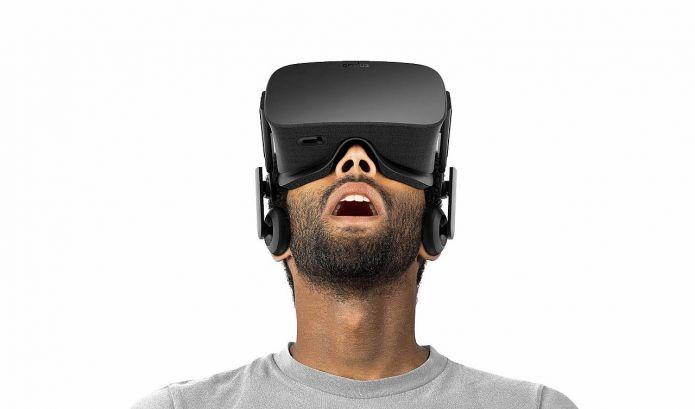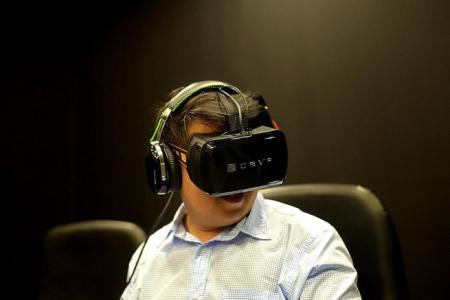Singapore coy in head to head competition with tech giants
Local contender in global virtual reality race with new headset
Virtual reality technology is taking the tech world by storm.
Since 2012, big companies such as Facebook-owned Oculus, HTC and Sony have poured big bucks into the technology that pundits are saying will change the way people interact with the computer.
And right up there among the big boys is Razer Inc — the homegrown company, co-founded by its Singaporean chief executive officer Tan Min Liang.
More famed for their gaming paraphernalia like mice, keyboards and sound systems, Razer is wading into the VR fight with its version, the Open Source Virtual Reality (OSVR) Hacker Development Kit, to global praise.
I try it out and find myself wowed by the stunning graphics.
I am immediately transported to a world where I see a mechanical beast emerge from beneath a highway, ripping apart cars and buildings.
I look to the side and see soldiers firing at the mechanical beast, shouting for cover. I watch, and dodge, as bullets whizz past in slow motion.
It all feels so real, until I notice the lack of heat from the explosions.
This is virtual reality, and a hint of what is to come.
"That's still work in progress but you get the idea," says Razer Asia-Pacific's marketing manager Jeevan Aurol, as he removes the prototype version of the OSVR from my head.
"VR allows us to wrap the entire environment around the user's head. The whole idea is one of immersion, and not just for video games too."
A good portion of OSVR's research and development takes place in the company's Chai Chee Lane facilities.
Instead of making things proprietary to the manufacturer, Razer has chosen to develop OSVR as an open-source platform and currently has partnerships with around 300 companies that are free to contribute to the open standard.
"That basically means that we can take technologies from different companies and make them work with one another," he explains.
His company's end goal is to produce a headset that would serve as a reference for other manufacturers to create their own, which may end up competing with Razer's products.
DARK AGES
Says Mr Aurol: "It is an interesting possibility. But we believe that at this stage of VR's development, being open-source and reducing the barriers to entry for developers is the way to go.
"We are still in the Dark Ages of VR, before the Renaissance that is to come."
Besides Razer, other Singaporean groups have taken a keen interest in VR too.
Nanyang Technological University, the National University of Singapore and James Cook University Singapore are using the OSVR in research labs.
The Asia VR Association, founded by Singaporean developer Tee Jia Hen early last year, holds bimonthly meetings at various locations for Singapore-based developers to discuss VR.
From 30 members initially, the group has swelled to nearly 400 members, with close to a hundred attendees at every meeting.
Some of the members have started their own companies that specialise in developing applications for the upcoming technology.
Says Mr Tee, 26: "Just watch all those YouTube videos of grannies screaming when they put on a VR headset. No other medium can evoke this kind of emotion.
"We are probably the leading Asian consumers of VR currently, but we are still not the top in developing it. Singapore really needs to be a part of this VR wave."
CONSUMER'S GUIDE TO VR HEADSETS
OCULUS RIFT
PRICE US$599 (S$860)
RELEASE DATE Pre-orders started in early January, ships in March 2016
Oculus started the global interest in consumer virtual reality technologies back in 2012 and has since been acquired by Facebook. It is widely regarded as the current leader and has released a more basic version, the Gear VR, in partnership with Samsung.


HTC VIVE
PRICE To be announced
RELEASE DATE April 2016
The Vive is a joint endeavour with Valve, a video game and distribution company that dominates the PC market. It is touted as a more premium version of VR, and the technology goes one step ahead of Oculus by allowing positional tracking - it can detect where you are in the room. It is also expected to be more expensive than the Oculus.

SONY PLAYSTATION VR
PRICE To be announced
RELEASE DATE First half of 2016
Originally called Project Morpheus, this headset is the ultimate accessory for PlayStation owners. Its hardware rivals that of the Oculus and the HTC Vive, but little else is known. More information is expected later this year.

RAZER'S OSVR HACKER DEVELOPMENT KIT
PRICE US$299 for the development kit. Price for the final version to be announced.
RELEASE DATE Development kit is available now.
At present, its hardware pales in comparison to the more premium offerings, but it is expected to cost less and does not require a top-of-the-line computer. As an open-source headset, the OSVR is upgradeable, potentially matching the other headsets in specification.

GOOGLE CARDBOARD
PRICE $10 to $40
RELEASE DATE Available now from various manufacturers.
Meant to be a low-cost way of experiencing what VR is all about, the Cardboard is literally a cardboard container that functions as a headset. Just pop in your smartphone and download the numerous VR apps available.
Get The New Paper on your phone with the free TNP app. Download from the Apple App Store or Google Play Store now



